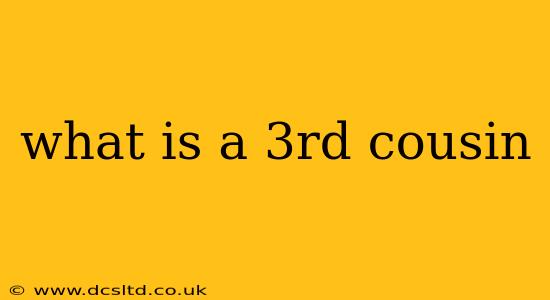Understanding family relationships beyond immediate family can be tricky. One such relationship that often causes confusion is that of a third cousin. This guide will clearly define what a third cousin is, explore how this relationship is determined, and answer some frequently asked questions.
What Does "Third Cousin" Mean?
A third cousin is a person who shares a great-great-grandparent with you. To visualize this, consider the following:
- You: You are the starting point.
- Your Grandparent: You share one set of grandparents with your first cousins.
- Your Great-Grandparent: You share one set of great-grandparents with your second cousins.
- Your Great-Great-Grandparent: You share one set of great-great-grandparents with your third cousins.
Essentially, you are connected through a common ancestor who is three generations removed from you.
How is a Third Cousin Relationship Determined?
The relationship is determined by tracing your family tree back to your common ancestor. You'll need to investigate both your family lineage and your third cousin's family lineage to find the shared great-great-grandparent. Genealogical software and websites can be helpful tools in this process. Sometimes, shared surnames or family stories can provide clues.
Are Third Cousins Related?
Yes, third cousins are indeed related, though distantly. They share a small percentage of their DNA, much less than closer relatives like siblings or even first cousins. While the degree of relatedness is small, it's still a significant connection in a genealogical sense.
What is the difference between a third cousin and a third cousin once removed?
A third cousin once removed is a generational step removed from a third cousin. This means that one person's connection to the great-great-grandparent is one generation closer than the other person. For example, your third cousin once removed would be the child (or grandchild etc.) of your third cousin.
How much DNA do third cousins share?
The amount of shared DNA between third cousins varies considerably depending on the specific family lines and inherited genetic material. On average, it is expected that third cousins would share a very small percentage of their DNA, often less than 1%. While not a significant amount, it's still enough to show a relationship in some genetic testing.
What are the legal implications of being third cousins?
In most jurisdictions, there are no legal implications of being third cousins. Laws regarding marriage between relatives typically focus on closer degrees of kinship to prevent genetic issues in offspring. The distant relationship of third cousins does not generally fall under these legal restrictions.
What is the social significance of being third cousins?
The social significance of being third cousins is largely dependent on personal and cultural contexts. In some families, the connection might be considered important enough to maintain a relationship, while in others, the distance might not lead to much interaction. It's a matter of individual and familial dynamics.
Understanding the nuances of family relationships like third cousins requires a careful examination of family trees and an appreciation of how generations connect. While the degree of relatedness may seem distant, the historical link is still valuable, especially for genealogical research and family history exploration.
